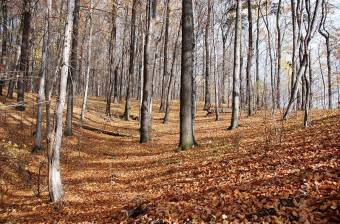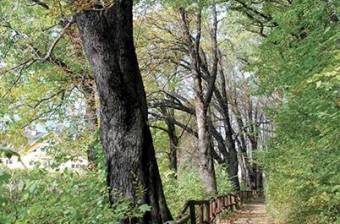Nature Reserves
The “Kopce” Nature Reserve
This forest reserve was set up in 1953. It comprises an isolated forest complex (14,76 ha) situated on a slope of the right side of the Olza valley, in the northern part of Cieszyn. In the reserve there are two forest communities; a sub-continental forest growing on dry ground and a Carpathian beech wood. In the former the dominant trees are the hornbeam and the durmast. The lime-tree (Tilia cordata), the maple-tree (Acer campestre), the sycamore, the larch (Larix europaea), and the Scotch elm also appear there, but are less frequent. In the brushwood there are: bird cherries, hawthorns, whitethorns, and hazel. In the rich undergrowth one can find cieszynianka wiosenna (Hacquetia epipactis), and also numerous species that typically appear in the forest growing on dry ground. Their Latin names are: Stellaria holostea, Hepatica, Galeobdolon luteum, Pulmonaria obscura, and Symphytum tuberosum. In the Carpathian beech wood the dominant tree is the beech (some specimens are of the size of ‘monuments of nature’) with the addition of sycamore, maple, ash and spruce. The brushwood is composed mainly of elder and in the undergrowth one can find species that are characteristic of beech wood, such as: (Latin):Dentaria glandulosa and , quite numerous here, Allium ursinum.
Among more than 100 species of vascular plants in the reserve, there are a few that are legally protected. These are:(Latin) Daphne mezereum, Hedera helix, Viburnum opulus, Neottia nidus-avis, Galium odoratum, Primula elatior, Convallaria majalis, Asarum europaeum, and Galanthus nivalis.
The Communal Woodland on the Puńcówka Reserve
It is a floristic reserve (partial), set up in 1961. It comprises a small isolated forest complex (6,96 ha), situated on the right side of the Olza valley, at the junction of the Puńcówka and the Olza.
The reserve was set up in order to protect the population of cieszynianka wiosenna (Hacquetia epipactis) and the forest growing on dry ground. Among the trees the dominant species are: ash-tree (Fraxinus excelsior), hornbeam, durmast, lime-tree (Tilia cordata), Scotch elm, elm, maple-tree, hedge maple, and sycamore. In the brushwood one can find numerous species of bushes with the dominant (at some places) elder. The undergrowth is also rich and it contains numerous plants characteristic of deciduous forests, forests growing on dry ground as well as a large population of cieszynianka wiosenna. The following species are legally protected: (Latin):Galanthus nivalis, Hedera helix, Primula elatior, Vinca minor, Asarum europaeum and Viburnum.
The reserve has remained under a very strong and negative influence of man. It is used as a park and a place for recreation. This causes “synanthropisation” of the flora (species of plants that grow in the places transformed by man enter the protected area) and the degradation of some of the parts of the reserve. The flora in the reserve contains 184 species of vascular plants.
The Communal Woodland on the Olza Reserve.
A floristic reserve, partial, set up in 1961. It comprises a narrow strip of deciduous forest (3,23 ha) that grows on a steep slope, the right side of the Olza valley, in the southern corner of the town.
The area has been under ‘reserve’ protection in order to preserve the population of cieszynianka wiosenna and a fragment of the forest growing on dry ground, of natural origin, with lime-tree, oak, hornbeam, maple, hedge maple, and sycamore. In the brushwood one can find the following: elder, dogwood, hazel, and hawthorns. In the undergrowth, apart from cieszynianka, there appear in great numbers: (Latin) Arum alpinum and a number of species characteristic of the forest growing on dry ground, e.g.: (Latin) Galium Schultesii. Among those legally protected one can find the following: (Latin) Convallaria majalis, Hedera helix, Asarum europaeum, Galanthus nivalis, Listera ovata and Epipactis helleborine. The reserve adjoins areas with buildings and is subject to very strong anthropopressure. At some places - parts of the woodland have been badly damaged.












